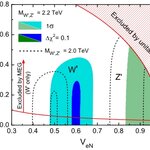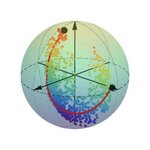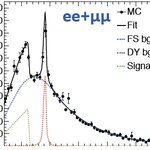Physics

After spending many years thinking about and writing about quantum gravity theories both mine and those of others I have come to the conclusion that a theory like M-Theory is the way to go. However, it has certain shortcomings. M-Theory relies on a fixed 11 dimensional background space to propagate and vibrate in. This is the reason that many physicist prefer other directions. M-theory does have one potential, it could be a blue print for a truly final and ultimate theory. Doug Sweetser pointed out in response to an earlier blog posting of mine that quantum…

Today the Cornell arxiv features a paper by J. Aguilar Saavedra and F. Jouaquim, titled "A closer look at the possible CMS signal of a new gauge boson". As I read the title I initially felt somewhat lost, as being a CMS member I usually know about the possible new physics signals that my experiment produces, and the fact that we had a possible signal of a new gauge boson had entirely escaped my attention. Hence I downloaded the paper and started reading it, hoping to discover I had discovered something new.
Alas, no. I only discovered that the signal which the theorists refer to is a mere 2.…

Tomorrow's commercial refrigeration systems, such as those in supermarkets, could be cooled by carbon dioxide instead of hydrofluorocarbons.
Hydrofluorocarbons are a greenhouse gas that is nearly 4,000 times more potent than CO2 and a future with less of them could be important because millions of pounds of HFCs leak into the environment every year, said Brian Fricke, a researcher in Oak Ridge National Laboratory's Building Equipment Research Group.
To address the problem, Fricke and colleagues are experimenting with CO2 and other refrigerants, including a hydrofluoroolefin called R1234yf.…

As I reported a couple of times in the course of the last three months, the ATLAS experiment (one of the two all-purpose experiments at the CERN Large Hadron Collider) has launched a challenge to data analyzers around the world. The task is to correctly classify as many Higgs boson decays to tau lepton pairs as possible, separating them from all competing backgrounds. Those of you who are not familiar with the search of the Higgs boson may wonder what the above means, so here is a crash course on that topic.
Crash course on the Higgs and its decays to tau leptonsThe Higgs boson is the…

As a quantum state collapses from a quantum superposition to a classical state or a different superposition, it will follow a path known as a quantum trajectory. For each start and end state there is an optimal or "most likely" path, but it is not as easy to predict the path or track it experimentally as a straight-line between two points would be in our everyday, classical world.
In a new paper, physicists have shown that it is possible to track these quantum trajectories and compare them to a recently developed theory for predicting the most likely path a system will take between two states…

UPDATE III is a rather important one. There is a group at Cambridge which does some similar work to mine. Great minds think alike, I guess. I have posted and revised a few times a paper on my new hypothesis for a theory of gravity which unifies Quantum Mechanics and General Relativity. Whenever someone writes "I have posted and revised a few times a paper on my new hypothesis for a theory of gravity which unifies Quantum Mechanics and General Relativity." The crank alarms should be flashing red alert, but I assure you all Einstein was quite right, but then so was…
In a different blog, Henry Brown made the following statement:
As mentioned previously, a scalar gravity theory will not do what you want. In particular, frame dragging effects rule out any scalar source theory. So we can discuss the 'big-picture' view on that more if you want. (And before plunging into yet another proposal it would be good to learn more about these big-picture issues.)
This blog will discuss this very issue.
Frame Dragging Effects
Back in 1918, Josef Lense and Hans Thirring published a paper in German on how the rotation of a central mass would…

Everybody seems to be talking about the Kardashian index (call it K) these days. It is a rather useless number that you compute as a ratio between the number of twitter followers you have and the number of citations that your papers got.
Here is a quote from its inventor Neil Hall:
“I am concerned that phenomena similar to that of Kim Kardashian may
also exist in the scientific community,” wrote Hall. “I think it is
possible that there are individuals who are famous for being famous (or,
to put it in science jargon, renowned for being renowned). We are all
aware that certain people are…

The other day I wrote a post reporting of the lowered expectations of SUSY enthusiasts, who now apparently look forward to seeing 2-sigma effects in the next Run data of the CMS and ATLAS collaborations. That would keep their hope going, apparently.
I would have no problem letting them wait for late 2015, when the first inverse femtobarns of 13 TeV collisions will have been given a look at. But another thing happened today which made me change my mind - a colleague noted in the comments thread of that article that the LHC experiments appear to not publish their 2- and 3-sigma excesses when…

In the world we commonly perceive around us, it takes only a slight disturbance for a pencil standing on its tip to fall in one direction or another, but in the quantum world it is possible in principle for particles of a system to fall both left and right at the same time.
Differentiating this “and” state – the quantum entanglement of particles – from the classical “or” is an experimental challenge. Scientists have now devised a
quantum metrology
method that enables entanglement verification for states of large atomic systems.
In their experiments, the team headed by Prof. Dr.…